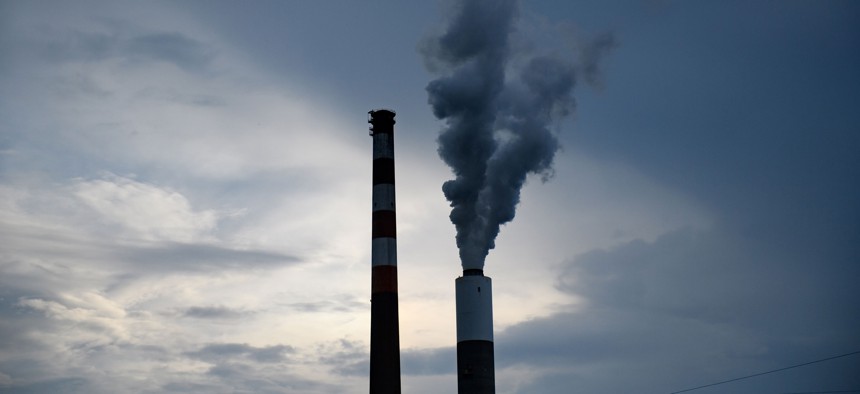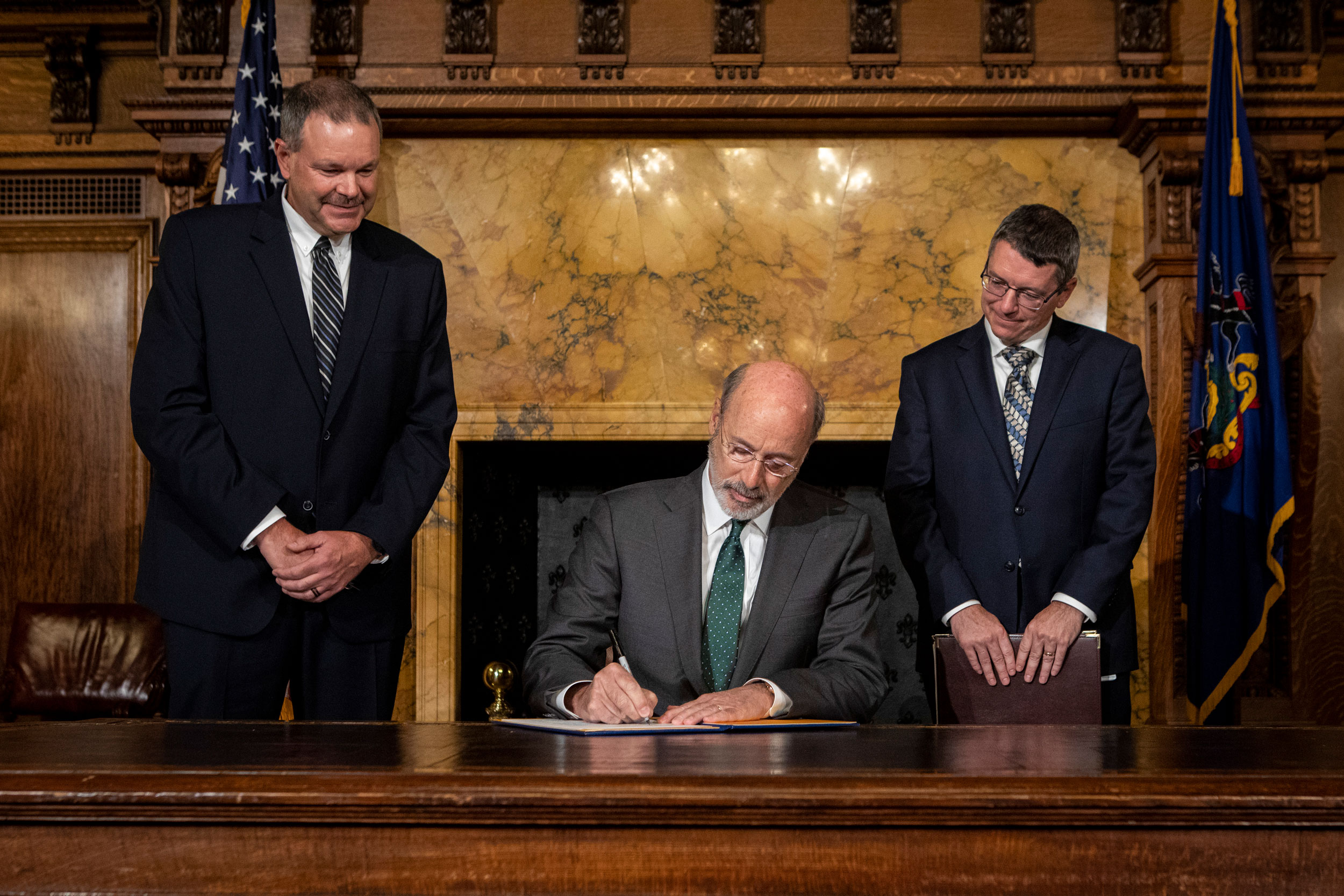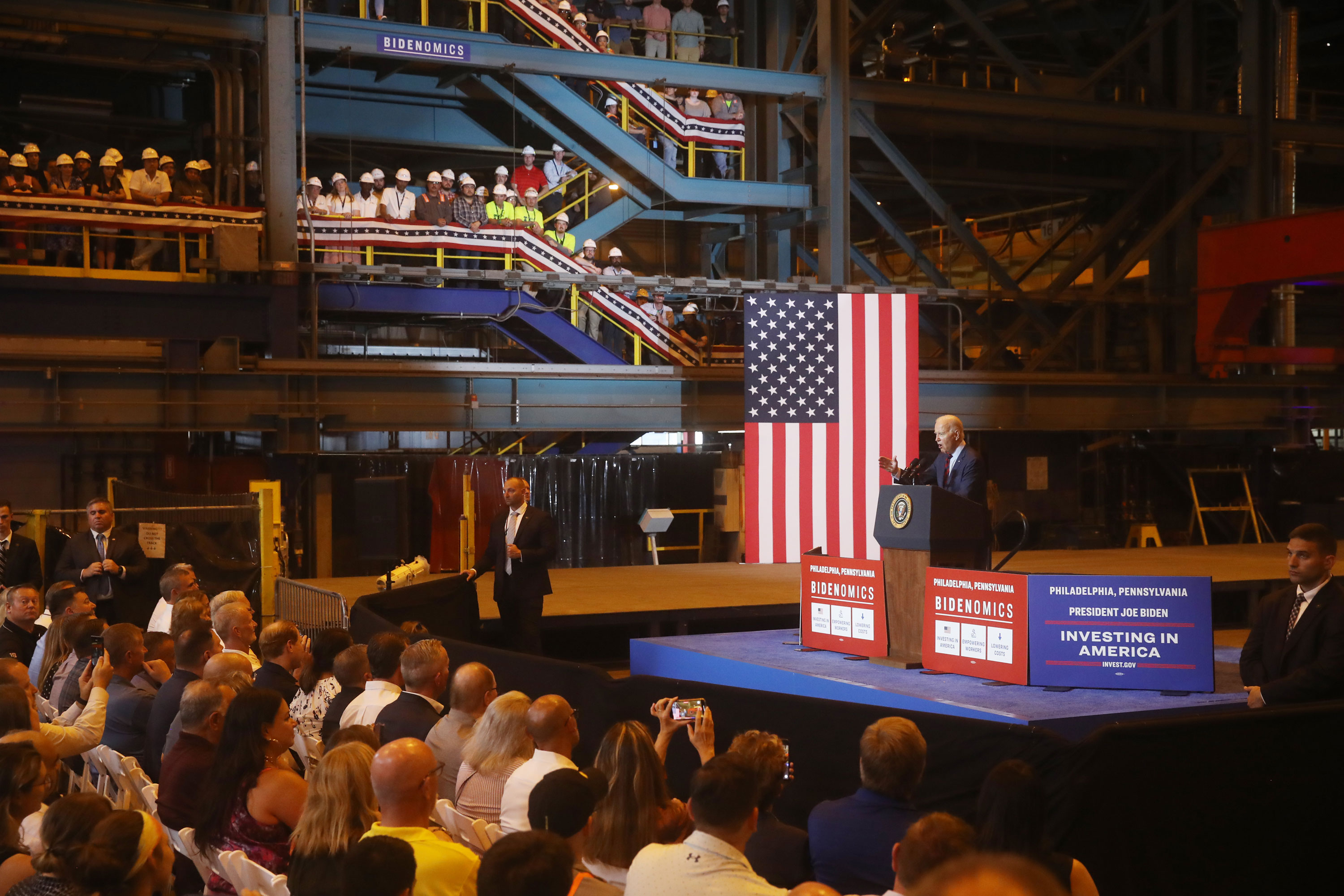Energy
Reconsidering the reckoning over RGGI
As both sides dig in ever deeper over the Regional Greenhouse Gas Initiative, fault lines and strategies become clearer, even as its future remains up in the air.

Coal is burned across Pennsylvania to produce electricity for the region. Jeff Swensen/Getty Images
The future of the commonwealth’s carbon emissions is up in the air – no cap.
The will-they-or-won’t-they dance between the state and the Regional Greenhouse Gas Initiative – an interstate compact that limits carbon emissions from power plants – is entering its third calendar year of legal and legislative back-and-forth.
But even as the state courts consider whether a governor has the executive power to enter the state into such an agreement, plenty of uncertainty surrounds how the commonwealth will prioritize production as it looks to cement and expand its role as a leader in the energy sector.
RGGI recap
RGGI is an interstate compact established in 2005 that requires emitters, such as power plants and large manufacturers, to purchase carbon allowances from the member state where they are emitting. Revenue from the carbon allowances, which decrease over time to reduce the state’s overall emissions, can be used to invest in renewable energy generation, support communities that are losing jobs because of the transition to cleaner energy production, and invest in communities historically impacted by high pollution levels.
RGGI has now been implemented in 11 states – Connecticut, Delaware, Maine, Maryland, Massachusetts, New Hampshire, New Jersey, New York, Rhode Island, Vermont and Virginia – with Pennsylvania’s proposed entrance coming through an executive order signed by then-Gov. Tom Wolf in 2019. Legislative efforts to reject RGGI ultimately came up short and in 2022, after the regulation was approved by the Independent Regulatory Review Commission and Environmental Quality Board, the final-form regulation was published, enabling Pennsylvania’s participation in RGGI.
The commonwealth’s entrance never took place, however. Opponents – among them state Republicans and industry groups – quickly opposed the move, calling it not only an abuse of power but a poor policy decision. The issue was also brought to the courts, with the opposition arguing that the emissions allowances qualify as a tax that can only be levied by the legislature, not through an executive order.
In November, after roughly two years of legal delays, the Commonwealth Court ruled against Pennsylvania joining RGGI. Gov. Josh Shapiro’s administration has appealed the ruling specifically related to executive authority while urging the legislature to act independently in the meantime and pass a cap-and-trade alternative to RGGI.
“The Commonwealth Court’s decision on RGGI – put in place by the prior administration – was limited to questions of executive authority, and our Administration must appeal in order to protect that important authority for this Administration and all future governors,” Manuel Bonder, a spokesperson for Shapiro, said in a statement. “Should legislative leaders choose to engage in constructive dialogue, the governor is confident we can agree on a stronger alternative to RGGI – if they take their ball and go home, they will be making a choice not to advance commonsense energy policy that protects jobs, the environment, and consumers in Pennsylvania.”
And while no legislative alternative has been introduced, state Sen. Gene Yaw, a Republican from Bradford County and chair of the Senate Environmental Resources & Energy Committee, recently introduced a bill, Senate Bill 1058, to repeal the program regulation promulgated by the Department of Environmental Protection and the EQB.
“For four years, Pennsylvania taxpayers have footed the bill for this unconstitutional, unilateral decision,” Yaw said in a statement. “RGGI is wrong for Pennsylvania, and it is time to repeal this regulation and focus on putting forth commonsense, environmentally responsible energy policy that recognizes and champions Pennsylvania as an energy producer.”
State Rep. Greg Vitali, chair of the House Environmental Resources & Energy Committee, said he’s hopeful the Shapiro administration will do more to lead the charge on green energy.
“Shapiro throughout his campaign said if a bill requiring 30% renewables by 2030 were to be put on his desk, he would sign it. We’re also waiting on the Shapiro administration for policy along those lines,” Vitali told City & State. “One of my observations – after having spent more than 30 years in state government – is that nothing really happens without the support of the governor.”
Reactions and reports
Wolf’s use of executive power – on top of the contentious energy policies the commonwealth would adhere to under RGGI – led to heated debate in Harrisburg over the future of Pennsylvania’s energy sector.
Republicans and industry leaders applauded the Commonwealth Court’s decision in November, arguing the program would cost the state jobs and raise energy bills for consumers.

Carl Marrara, vice president of government affairs for the Pennsylvania Manufacturers’ Association, questioned the need for a statewide program aimed at reducing carbon emissions, arguing that the commonwealth has already reduced its emissions significantly in recent years with the proliferation of natural gas production.
“Are we implementing a solution in search of a problem?” Marrara asked rhetorically during an interview with City & State. “You’re seeing the market do exactly what the market should do, and that is create efficiencies and develop technologies, which ultimately lowers emissions. I don’t know that we need any government interference to make that happen at a faster rate than it already is.”
Pennsylvania has seen a reduction in carbon emissions in recent years. According to the state Department of Environmental Protection, statewide net emissions decreased 25.9% from the 2005 baseline, largely due to fuel sources switching from coal to natural gas.
Nonetheless, discussions regarding cutting carbon emissions and planning Pennsylvania’s energy future have continued. When Shapiro took office in 2023, he created a working group of stakeholders, including organized labor, energy leaders, and environmental and consumer advocates, to “evaluate the merits of Pennsylvania’s membership in RGGI and any proposed alternatives.”
The working group’s findings, released last September, resulted in a vague but broad consensus that reducing carbon emissions is necessary and inevitable, and included the conclusion that “any cap-and-invest program should include policy levers and investment strategies which help avoid any potential emissions leakage, higher localized pollution, increased energy costs, and job loss.”
Brian Regli, executive director of the Office of Critical Investments within the governor’s office, told City & State that the transition to green energy shouldn’t result in increased unemployment.
“Ultimately, we don’t think there are any job losses in this,” Regli told City & State, saying those in the energy industry can leverage what they already know to transition to growing job fields. “You’re going to be doing things that are involved in drilling when you’re going for geothermal wells, or you’re going to do things that are involved in grid enhancements when you’re adding more electrons onto the grid.”
Marrara said the job losses and communities impacted by an abrupt shift toward renewable energy shouldn’t be downplayed.
“We are for all forms of energy as long as those forms of energy compete in an open market and the government is not picking winners and losers,” Marrara told City & State. “Telling those guys that have put in just massive amounts of training to work on these complex (energy production) systems, ‘Hey, now you’re going to slap solar panels in the ground’ … it is insulting.”
In contrast, a 2023 analysis conducted by the University of Pennsylvania’s Kleinman Center for Energy Policy and Resources for the Future found that if the commonwealth were to adopt the RGGI standards, it could reduce emissions and generate additional revenue, with more jobs being created in renewable and nuclear energy than would be lost in the coal industry by 2030.
The report estimated that by joining RGGI, Pennsylvania could reduce electricity sector emissions by 25 to 28 million metric tons, equivalent to 84% below 2020 emissions levels. It noted that the state would also generate anywhere from $101 million to $148 million from the auction of emissions allowances in 2030, some of which could be spent on programs to assist impacted communities and consumers with electricity bills.
“With participation in RGGI, the state has an opportunity to use the auction proceeds to ensure that the transition to clean power is just and equitable and that the communities most affected by the job losses benefit not only from air quality improvements but also from job creation and economic welfare,” the report added. “If Pennsylvania remains outside RGGI, coal plants will likely continue to shut down but the state will not have the extra revenues to provide options to the affected communities.”
Revamped resolutions
As both sides of the RGGI debate remain in wait-and-see mode, many – including the governor – are calling for the legislature to take matters into their own hands.
“We urge Republican and Democratic leadership to join us at the productive table the Governor has set with labor, environmental advocates, energy producers, and consumer advocates to further a commonsense energy policy that moves our Commonwealth forward. Now is the time for action, inaction is not an acceptable alternative,” Bonder said in a statement.
Despite this, industry leaders aren’t holding their breath that a clean energy program is on the horizon.
“If (solar and wind) technologies are both environmentally beneficial and economically beneficial, certainly I think that those should be developed,” Marrara said. “I don’t think that the government choosing that technology over something else is necessarily the answer.”

Yaw said he wouldn’t close the door on talks about other cap-and-trade proposals, but expressed concern with the concept of Pennsylvania’s energy production being tied to other states. “The idea of putting us in RGGI – that had a tremendous economic impact on Pennsylvania,” he told City & State. “That happened in 2019 – we have not had a major investment in electricity power generation since then. I don’t blame companies. They say, ‘Well, wait a minute. This is a new carbon tax. Why should we come to Pennsylvania and do business when we can go elsewhere and get a greater return on our money?’”
In the only split General Assembly in the nation, inaction may be an accepted reality. Vitali said that given the holdups with RGGI and the lack of movement related to green energy initiatives in the legislature, the federal government will have to play a bigger role in pushing states toward renewable energy.
“President Biden needs to be commended for the monies in federal programs like the Inflation Reduction Act and for incentivizing things like electric vehicle charging stations, well-plugging and other methods to address climate issues,” Vitali said. “Federal government leadership on this issue is crucial.”

Regli, whose role includes leveraging federal dollars and tax credits available through legislation like the Inflation Reduction Act, said such federal investments can “ensure that Pennsylvania retains its position as an all-the-above energy state that has all kinds of opportunities to lead the transformation of the energy complex in the United States.”
Vitali, who has spent 28 years on the House Environmental Resources and Energy Committee, said he hasn’t seen any concrete plans to set the state on a path toward prioritizing renewable energy.
“Frankly, Pennsylvania is not really doing much to address climate change,” Vitali said. “It just seems like our salvation, if it’s to come, would need to come from the federal level.”
As it stands, the Shapiro administration’s appeal to the state Supreme Court is being considered. However, given the time it took the Commonwealth Court to decide on the state’s entrance into RGGI, there is an assumption Pennsylvania won’t be getting a final decision anytime soon.
The lower court decision “took far longer than anyone anticipated,” Marrara said, adding that in regard to future action by the state Supreme Court, “I think it’s going to be quite some time before we see any movement.”
